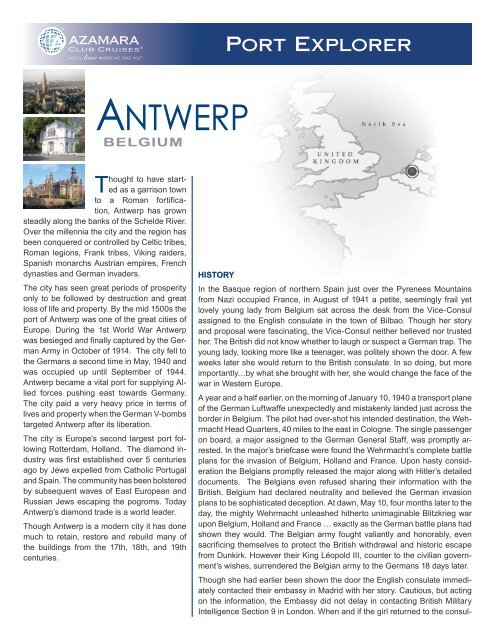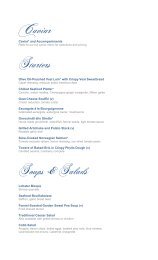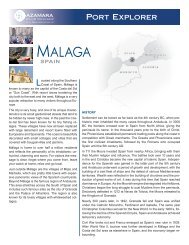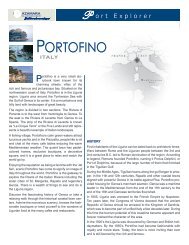Download Port Explorer Guide - Azamara Club Cruises
Download Port Explorer Guide - Azamara Club Cruises
Download Port Explorer Guide - Azamara Club Cruises
Create successful ePaper yourself
Turn your PDF publications into a flip-book with our unique Google optimized e-Paper software.
ANTWERPBELGIUMThought to have startedas a garrison townto a Roman fortification,Antwerp has grownsteadily along the banks of the Schelde River.Over the millennia the city and the region hasbeen conquered or controlled by Celtic tribes,Roman legions, Frank tribes, Viking raiders,Spanish monarchs Austrian empires, Frenchdynasties and German invaders.The city has seen great periods of prosperityonly to be followed by destruction and greatloss of life and property. By the mid 1500s theport of Antwerp was one of the great cities ofEurope. During the 1st World War Antwerpwas besieged and finally captured by the GermanArmy in October of 1914. The city fell tothe Germans a second time in May, 1940 andwas occupied up until September of 1944.Antwerp became a vital port for supplying Alliedforces pushing east towards Germany.The city paid a very heavy price in terms oflives and property when the German V-bombstargeted Antwerp after its liberation.The city is Europe’s second largest port followingRotterdam, Holland. The diamond industrywas first established over 5 centuriesago by Jews expelled from Catholic <strong>Port</strong>ugaland Spain. The community has been bolsteredby subsequent waves of East European andRussian Jews escaping the pogroms. TodayAntwerp’s diamond trade is a world leader.Though Antwerp is a modern city it has donemuch to retain, restore and rebuild many ofthe buildings from the 17th, 18th, and 19thcenturies.HISTORYIn the Basque region of northern Spain just over the Pyrenees Mountainsfrom Nazi occupied France, in August of 1941 a petite, seemingly frail yetlovely young lady from Belgium sat across the desk from the Vice-Consulassigned to the English consulate in the town of Bilbao. Though her storyand proposal were fascinating, the Vice-Consul neither believed nor trustedher. The British did not know whether to laugh or suspect a German trap. Theyoung lady, looking more like a teenager, was politely shown the door. A fewweeks later she would return to the British consulate. In so doing, but moreimportantly…by what she brought with her, she would change the face of thewar in Western Europe.A year and a half earlier, on the morning of January 10, 1940 a transport planeof the German Luftwaffe unexpectedly and mistakenly landed just across theborder in Belgium. The pilot had over-shot his intended destination, the WehrmachtHead Quarters, 40 miles to the east in Cologne. The single passengeron board, a major assigned to the German General Staff, was promptly arrested.In the major’s briefcase were found the Wehrmacht’s complete battleplans for the invasion of Belgium, Holland and France. Upon hasty considerationthe Belgians promptly released the major along with Hitler’s detaileddocuments. The Belgians even refused sharing their information with theBritish. Belgium had declared neutrality and believed the German invasionplans to be sophisticated deception. At dawn, May 10, four months later to theday, the mighty Wehrmacht unleashed hitherto unimaginable Blitzkrieg warupon Belgium, Holland and France … exactly as the German battle plans hadshown they would. The Belgian army fought valiantly and honorably, evensacrificing themselves to protect the British withdrawal and historic escapefrom Dunkirk. However their King Léopold III, counter to the civilian government’swishes, surrendered the Belgian army to the Germans 18 days later.Though she had earlier been shown the door the English consulate immediatelycontacted their embassy in Madrid with her story. Cautious, but actingon the information, the Embassy did not delay in contacting British MilitaryIntelligence Section 9 in London. When and if the girl returned to the consul-
ate officers from MI9 would be waiting for her. Her name wasAndrée de Jongh and she did return to the consulate and withher she brought a number of downed British pilots and aircrew that she had smuggled out of Belgium, across Nazi heldFrance, over the mountains to Spain and right to the front doorof the consulate.The officers of MI9, resolute men of war, were stunned as shedescribed her plan to rescue more, many more downed Englishflyers. The British government and military were amazedand immediately offered Miss de Jongh their gratitude, fullsupport…and respect. Over the next four years “Le RéseauComète” (The Comet Line) would grow to include countlessBelgians who, with utter disregard for their own safety, rescueddowned English and Allied air crews. The story of theirincredible bravery and sacrifice in the face of overwhelmingNazi terror is the stuff of legends. The flyers were hiddenin homes, apartments and farm houses. Their woundswere cared for, civilian clothes and false identity papers wereprovided, then … hunted every minute and every step of theway … they were secreted out of Nazi occupied Belgium andFrance and, with the help of Basque shepherds, across themountains into Spain. From there the men of MI9 took the aircrews south to Gibraltar and back to England from where theywould fly to fight the Nazis another day.The danger met by the Belgians of the Comet Line and the“Réseau de Résistance” (Resistance Network) is unimaginableand matched only by their heroic courage. Many werecaptured and faced immediate execution, among them Missde Jongh’s own father. And, as was the fate of Miss de Jongh,many were often betrayed by Nazi collaborators. They wereimprisoned and interrogated at the hands of the Gestapo undergoingunspeakable torture only to be summarily deportedto the concentration camps. Yet in the midst of such hardshipand adversity, over 800 Allied flyers were rescued andreturned safely to England. The frightful price in lives washigh…nearly one for one…a Belgian Comet Line or résistancefighter died for every Allied flyer saved. Today and forever Andréede Jongh and the Belgian men and women that sharedher love of freedom are remembered with high honor in theannals of the British RAF and the United States Air Force.Eternally grateful must be the present and future generationsof descendants of those flyers that were shot out of Europeanskies…flyers whose lives and thus their progeny, were savedthrough the valor, sheer audacity and steely nerves of petiteand unassuming Andrée de Jongh and the Belgians, Frenchand Basque of “Le Réseau Comète”.© 2010 maps.com4326 51ANTWERP PLACES OF INTEREST1Rubenshuis (The Rubens House) was the home andstudio of the famed artist Pieter Paul Rubens. The 17thcentury master moved into this house with his wife and childrenin 1611. It was here that Rubens created a number ofhis best works. Today the palatial building is a museum dedicatedto his life and career.2St. Jacobskerk (The Church of Saint Jacob) is a gothicstyle building. It has many beautiful wood and marblecarvings. Its most famous artwork is “Our Lady Surrounded bySaints” by Rubens. The church is located close to the RubensHouse and is the final resting place of the great painter.
3Onze Lieve Vrouwe Kathedraal(Our Lady’s Cathedral) was designedand built in the classic gothic style. It is thelargest church in Belgium and a prominentsymbol of the city. Two Rubens masterworks are on display; the three paneled“Elevation of the Cross” (1610) and “Descentof the Cross” (1612). These paintingsare deemed by many art critics to beamong the greatest art works of the ages.4De Steen Castle is part of the originalfortifications that once encircledand protected the city. Construction beganearly in the 1200s. Today the castle ishome to Antwerp’s National Maritime Museumthat tells the story of the city’s longmaritime history.5The Plantin Museum is home to thefamous, and now priceless, printingspresses and archives of Christoffle Plantinand his descendants. Mr. Plantin was a tremendouslyinfluential and successful printerand publisher in the late 1500s and hisfamily carried on the work for generations.Many of the books that he and his familypublished are now literary treasures. In additionto the printing workshop guests canvisit the family residence. The prominenceof the Plantins is attested to by the familyportraits in the home that were painted bynone other than Antwerp’s great master,Peter Paul Rubens.6The Diamond Museum relates the500 year history of the relationshipbetween Antwerp and the diamond industry…atrade that thrives to this day. Visitorshave the opportunity to see how theprocess of mining, sorting, grading, cuttingand polishing the stones has evolved. Anamazing collection of jewelry is on display.SHORE EXCURSIONSTo make the most of your visit to Antwerp and surrounding areas we suggestyou take one of the organized Shore Excursions. For information concerningtour content and pricing, consult your Shore Excursion Order Form or contactthe Shore Excursion Desk. When going ashore, be advised to take only necessaryitems and secure any valuables onboard.LOCAL CUSTOMSBargaining: Prices are generally fixed.Tipping: A service charge is usually added to most bills. For exceptional servicea Euro or two might be offered. Many people simply leave some change.LOCAL CUISINE AND DRINK SPECIALTIESIn the Middle Ages Belgium became a thriving center for the importation of spicesinto Northern Europe. Close proximity to France and Germany have alsoinfluenced Belgian cuisine. Some traditional favorites include: Cream of EndiveSoup, combines garlic, onions, potatoes, butter, chives, endives, chicken stockand cream. Anguille au Vert, is eel smothered in a rich sauce that combineslemon juice, fresh herbs, eggs, butter and white wine. Wild Boar Carbonnade,is a hearty stew made with cubed boar meat, onions, fresh herbs, juniper berriesand dark beer. Brussels Sprouts in Beer are … well… Brussels sprouts sautéedin beer. Belgian Chocolate, 350,000,000 pounds (yes that is million) a year, isfamously some of the best in the world. For the most part Belgians still maketheir chocolate by hand, the old fashion, in thousand of little shops and storesall over the country. Belgian Waffles … there is something confusing aboutBelgian Waffles … Belgians don’t eat them. Mr. Maurice Vermersch (a Belgian)introduced his wife’s recipe to America in the 1964 New York World’s Fair.Belgium is famous for its beer. As with many parts of northern Europe, beer hasbeen brewed here since far back in the middle ages. There are many differentBelgian beers … among them, Trappist and Abbey.SHOPPINGMeir Street is Antwerp’s primary shopping district. Many of the beautiful buildingsdate back to the 1700s. There are numerous shops of all kinds and wonderfulcafes in which visitors can relax and refresh.Of course, among the most popular items to buy in Antwerp are those shinylittle hand carved bits of pure carbon that, at a temperature around 2,500°F, 120miles deep into the earth’s lithospheric mantle for the past 1-3 billion years, havebeen under 450 tons of pressure per square inch (think of a fully loaded 747tipped on its nose with all its weight on a single BBQ briquette). To phrase it simply… from the Greek word meaning “indestructible” … “adámas” … diamond.In Antwerp generations of highly skilled professionals do wondrous things withtwo carbon atoms that, under the conditions described above, have covalentlybonded to four other carbon atoms into a tetrahedral lattice arrangement to forma 3-dimensional network ring of atoms that share pairs of electrons. And thesecarbon atoms, true star dust, the very foundation of the universe, when joinedwith hydrogen and oxygen form the basic element of life on earth. So amazing ispure carbon, the nuclear icing on the molecular cake…so to speak…that it hasthe power to join hearts and destinies, so that when slipped upon a lover’s fingerthe probability is high that they will laugh or cry and say “I do”… and all will beright in their universe.LOCAL CURRENCYBelgium’s currency is the Euro (€, EUR). Major credit cards are widely accepted.
POST OFFICE AND TELEPHONE FACILITIESThe Post Office is located in the city centre #43 Groenplaats.TRANSPORTATIONRental cars and taxis are widely available. Antwerp has aninexpensive, clean, safe and user-friendly public transportationsystem that includes buses, trains and the undergroundmetro system. To get to the train station passengers will needto take a taxi. Public transportation near the cruise terminalis not very convenient. It is best to walk to the Groenplaats,where the tram and bus are operating.TOURIST INFORMATIONThe Tourist Information Center located at the Market Square,at #13 Grote Markt, within easy walking distance from theship. Usually there is a desk with tourist information inside theterminal building.USEFUL WORDS AND PHRASESThere are 3 major languages spoken in Belgium: French,Dutch and German. In general, English is well understoodand spoken. North of Brussels people speak Dutch. Southof Brussels people speak French and close to the Germanborder, people speak German.English - Dutch - Frenchhello - goeiedag - bonjourI don’t know - ik weet het niet - je ne sais pashow are you - hoe gaat het? - comment ça vaplease - alstublieft - s’il vous plaîtthank you - bedankt - mercigood bye - vaarwel - au revoir____________________________________________________________________________________________________________________________________________________________________________________________________________________________________________________________________________________________________________________________________________________________________________________________________________________________________________________________________________________________________________________________________________________________________________________________________________________________________________________________________________________________________________________________________________________________________________________________________________________________________________________________________________________________________________________________________________________________________________________________________________________________________________________________________________________________________________________________________________________________________________________________________________________________________________________________________________________________________________________________________________________________________________________________________________________________________________________________________________________________________________________________________This information has been compiled for the convenience of our guests and is intended solely for that purpose.While we work to ensure that the information contained herein is correct, we cannot accept responsibility for any changes that may have taken place since printing.© RCCL 2013 - All rights reserved.
















